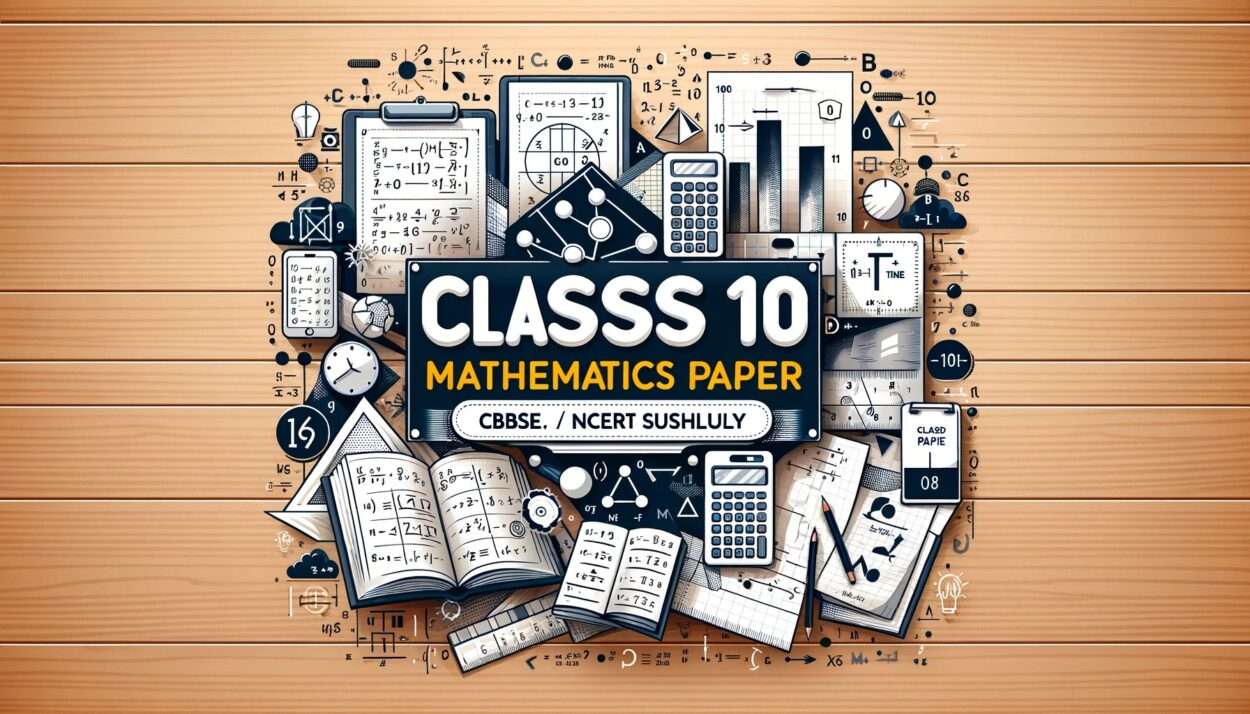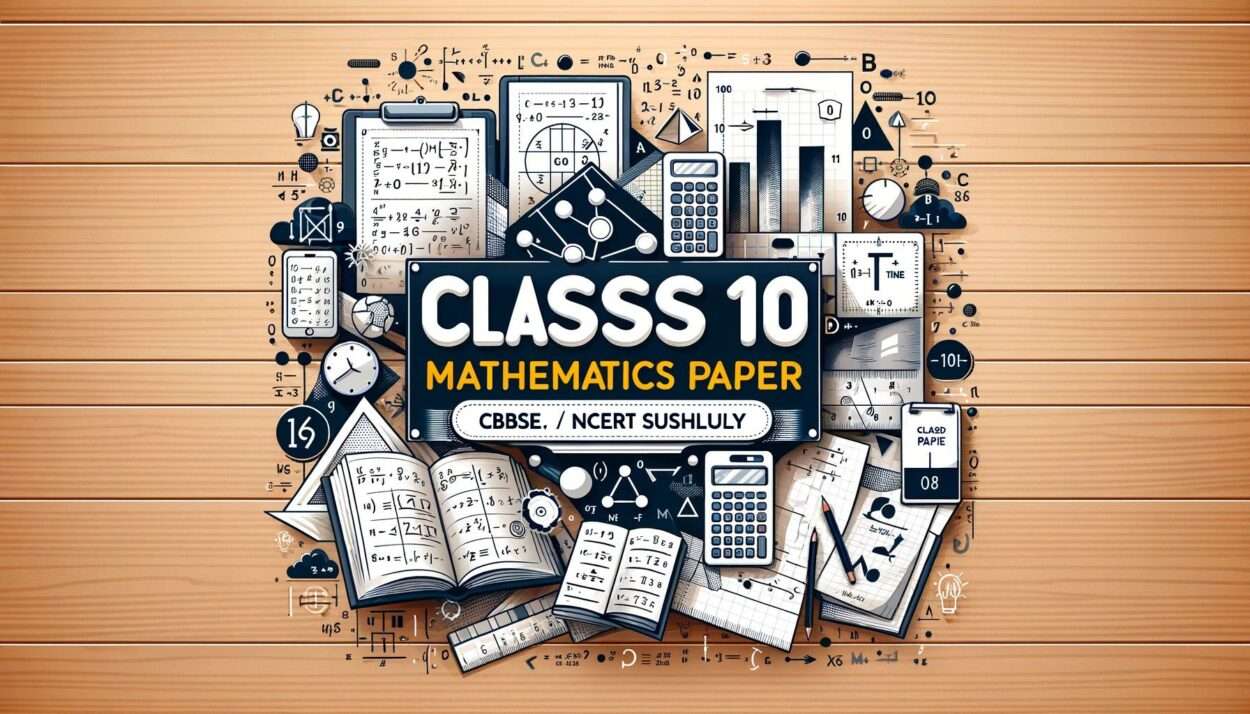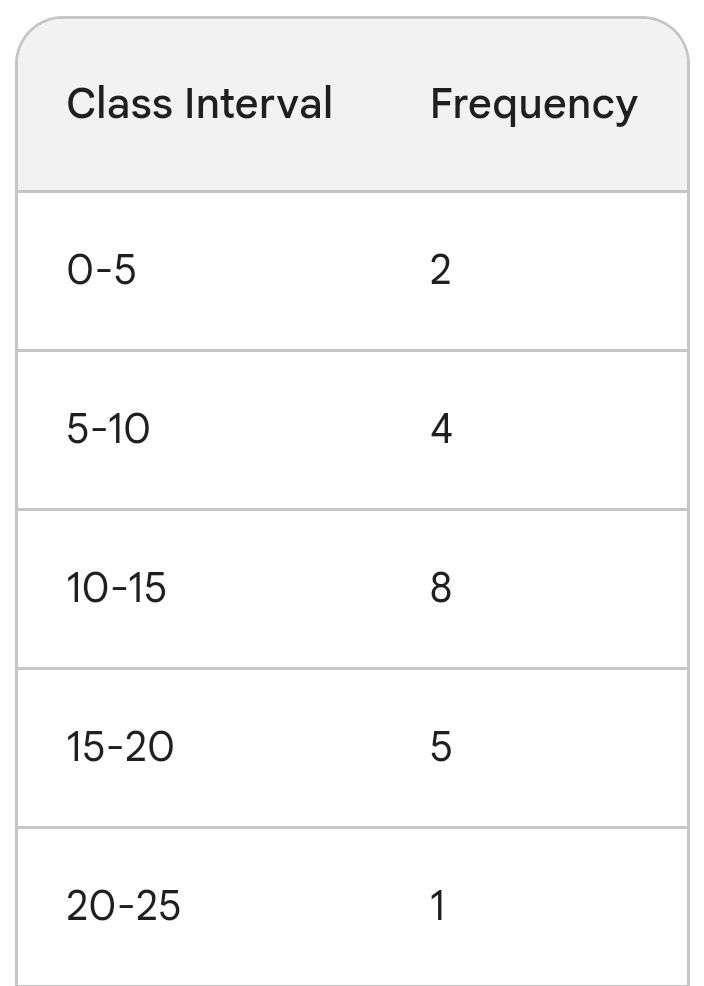
Class 10 Mathematics Model Paper (CBSE/RBSE, NCERT Syllabus)

Class 10 Mathematics Model Paper (CBSE/RBSE, NCERT Syllabus)

Total Marks: 80
Instructions:
- Answers to all sections must be written in your answer booklet.
- All necessary working must be shown in detail.
- Use of pen is recommended.
- Calculators are allowed.
Time: 3 hours
Section A (Objective Questions, 1 mark each, Total 15 marks)
- Find the HCF of 18 and 24. [Answer: 6]
- What is the quadratic equation whose roots are -2 and 5? [Answer: x^2 + 7x – 10 = 0]
- The slope of the line passing through points (1, 2) and (4, 5) is: [Answer: 1]
- The area of a parallelogram with base 8 cm and height 5 cm is: [Answer: 40 sq cm]
- In a right-angled triangle ABC, ∠C = 90°, AB = 10 cm, and AC = 6 cm. Find BC. [Answer: 8 cm]
- The median of the set {3, 5, 8, 12, 14} is: [Answer: 8]
- What is the probability of getting a tail when a fair coin is tossed? [Answer: 0.5]
- If f(x) = x^2 – 3x + 2, find f(1). [Answer: 0]
- The value of cos 45° is: [Answer: √2/2]
- In a circle, the ratio of the areas of two concentric circles is 4:1. What is the ratio of their radii? [Answer: 2:1]
- The volume of a cylinder with radius 4 cm and height 10 cm is: [Answer: 160π cu cm]
- What term of the A.P. 7, 14, 21, … is 84? [Answer: 13th term]
- The equation of the line passing through the point (2, 4) and perpendicular to the x-axis is: [Answer: y = 4]
- The standard deviation of the set {4, 6, 7, 10, 12} is: [Answer: 2.8]
- If an event E has a probability of 0.7, what is the probability of its complement? [Answer: 0.3]
Section B (Short Answer Questions, 2 marks each, Total 10 marks)
- Solve the linear equations: x + 2y = 5 and 3x – y = 4. [Answer: x = 1, y = 2]
- Simplify: (x + 1)(x – 2) – (x – 3)(x + 4). [Answer: -7x – 11]
- Factorize: x^2 + 2x – 8. [Answer: (x + 4)(x – 2)]
- Find the equation of the line passing through the points (-1, 3) and (5, -7). [Answer: y = -2x + 1]
- Prove that the sum of the angles in a quadrilateral is 360°.
- Find the area of a sector with central angle 60° and radius 5 cm in a circle of radius 10 cm. [Answer: 12.5π sq cm]
- Calculate the mean, median, and mode of the set {8, 5, 7, 9, 5, 6, 8}. [Answer: Mean = 7, Median = 7, Mode = 5, 8]
- If A and B are events such that P(A) = 0.4 and P(B) = 0.6, find P(A ∪ B). [Answer: 0.84]
- Draw the graph of the equation y = x^2 – 2x + 3.
- Find the distance between the points (0, 2) and (3, 5). [Answer: √13]
Section C (Long Answer Questions, 5 marks each, Total 30 marks)
- Solve the quadratic equation x^2 – 8x + 12 = 0. [Answer: x = 2, 6]
- Prove that the area of a triangle is 1/2 * base * height. [Hint: Draw a triangle and divide it into two right-angled triangles using its altitude. Use similarity to relate the sides and areas.]
- Find the volume of a cone with radius 8 cm and height 15 cm. [Hint: Remember the formula for the volume of a cone and substitute the given values.]
- Derive the formula for the area of a trapezium using similar triangles. [Hint: Divide the trapezium into a parallelogram and a triangle. Use the area formula for each figure and combine them.]
- A train covers 225 km in 5 hours. Find its speed in km/hr. [Hint: Convert hours to minutes and then calculate speed in km/hr.]
- Construct a triangle ABC, given AB = 10 cm, BC = 7 cm, and ∠A = 60°. [Hint: Use the Law of Cosines to find the missing side and then the Law of Sines to find the remaining angles.]
- Draw the cumulative frequency curve for the following data:

Hint: Plot the cumulative frequencies on a graph and connect the points with lines.]
- A bag contains 5 red balls, 4 white balls, and 3 blue balls. A ball is drawn at random. Find the probability of:
(a) drawing a red ball; (b) drawing a ball that is not blue.
[Hint: Divide the number of desired balls by the total number of balls for each part.]
- Solve the system of equations: 3x + 2y = 11 and 2x – y = 4. [Hint: Try eliminating one variable using addition or subtraction of equations.]
Additional Questions:
- Find the equation of the tangent to the circle centered at (1, 3) with radius 4 at the point (5, 5).
- A coin is tossed three times. Calculate the probability of getting at least one head.
- Solve the system of equations: x + y + z = 6, x – y + z = 2, and x – y – z = 4.
- Find the area of the shaded region in the following figure: [Insert image of a figure with shaded region]
- Prove that the sum of the squares of the diagonals of a parallelogram is equal to twice the sum of the squares of its sides.
Additional Questions:
- Find the equation of the tangent to the circle:
- Use the formula for the derivative of the equation of a circle to find the slope of the tangent at the given point.
- Use the point-slope form of the equation of a line to write the equation of the tangent.
- Probability of getting at least one head:
- Calculate the probability of getting no heads using complementary probability.
- Subtract this probability from 1 to get the probability of getting at least one head.
- System of three equations:
- Try eliminating two variables at once using addition or subtraction of equations.
- Solve the resulting equation for the remaining variable.
- Substitute the value back into the original equations to find the other variables.
- Area of shaded region:
- Identify the shapes involved in the shaded region (e.g., triangles, rectangles, sectors).
- Use the formulas for the areas of these shapes to find their individual areas.
- Subtract the area of the unshaded region from the total area to find the area of the shaded region.
- Sum of squares of diagonals:
- Express the squares of the diagonals of the parallelogram in terms of its sides.
- Use the Law of Cosines or other relationships between the sides of the parallelogram to simplify the expressions.
- Show that the sum of the squares of the diagonals is equal to twice the sum of the squares of the sides.
Section D (Higher Order Thinking Skills, 5 marks each, Total 20 marks)
Instructions:
- Attempt any four questions out of five.
- Show your working clearly and logically.
- Diagrams and figures can be used where appropriate.
- (Challenge – Problem Solving) A farmer has 120 meters of fencing to enclose a rectangular vegetable patch. Let the length of the patch be x meters and the breadth be y meters. (a) Write down an equation relating x and y using the total fencing length. (b) Find the dimensions of the rectangular patch that maximizes its area. (c) What is the maximum area that the patch can have?
- (Application – Project Management) A group of students decides to organize a fundraising bake sale. They estimate that they need to bake and sell 200 cupcakes to reach their target amount. Each student can bake 10 cupcakes per hour. (a) If all students work together, how many hours will it take to bake the required number of cupcakes? (b) Some students have additional commitments and can only bake for 2 hours. How many students need to participate in the baking to reach the target in those 2 hours? (c) Suggest other factors (besides time) that the students should consider when planning the bake sale.
- (Analysis – Statistics) A class of 30 students was given a mathematics quiz. The marks obtained by the students are:
7, 8, 9, 9, 10, 10, 11, 11, 12, 12, 13, 13, 13, 14, 14, 15, 15, 15, 16, 16, 17, 18, 19, 19, 20, 20, 20, 20, 20, 20
(a) Calculate the mean, median, and mode of the marks. (b) Construct a frequency table and a cumulative frequency curve for the data. (c) Based on the data, comment on the overall performance of the class in the quiz.
- (Proof – Geometry) In a triangle ABC, ∠A = 90°, AB = 10 cm, and AC = 8 cm. Let D be the foot of the perpendicular from B to AC. Prove that AD = 6 cm.
- (Creativity – Open Ended) A mathematician is walking on a straight path. At a certain point, they turn left at an angle of θ degrees and walk for a distance of d meters. They then turn right at an angle of 2θ degrees and walk for the same distance of d meters. Finally, they turn left again at an angle of θ degrees. (a) Will the mathematician end up at their starting point after completing this path? Explain your reasoning. (b) If the answer is yes, what are the possible values of θ for which the mathematician returns to their starting point? (c) Can you think of any real-world applications for this situation?
Section E (Project Work / Case Studies):
Possible Topics:
- Environmental: Estimating water usage in a school, calculating carbon footprint of a daily commute, analyzing energy consumption patterns in a building.
- Finance: Modeling investment returns, analyzing loan repayment options, planning a budget for a school event.
- Engineering: Optimizing bridge design, calculating forces on a rollercoaster, analyzing data from a weather station.
- Daily Life: Scheduling tasks to maximize efficiency, designing a game based on probability theory, analyzing sports statistics.
Section F (Group Discussion / Open Debate):
Possible Topics:
- Should calculators be allowed in all math exams?
- Is Big Data a threat to our privacy?
- Is artificial intelligence superior to human intelligence?
- Is cryptography a barrier to free speech?
- Should mathematics be mandatory for all students?
Section G (Creative Expression / Storytelling):
Themes:
- Mathematical puzzles and paradoxes: The Infinity Hotel, Zeno’s Paradox, The Banach-Tarski Paradox.
- Historical figures and discoveries: Pythagoras and the Pythagorean Theorem, Alan Turing and codebreaking, Ada Lovelace and the first computer program.